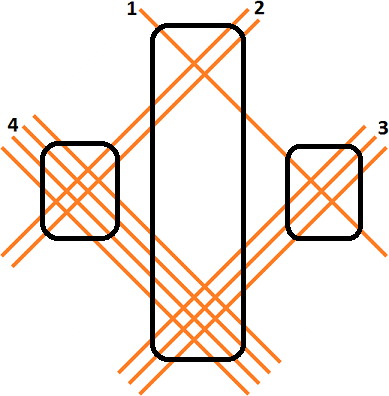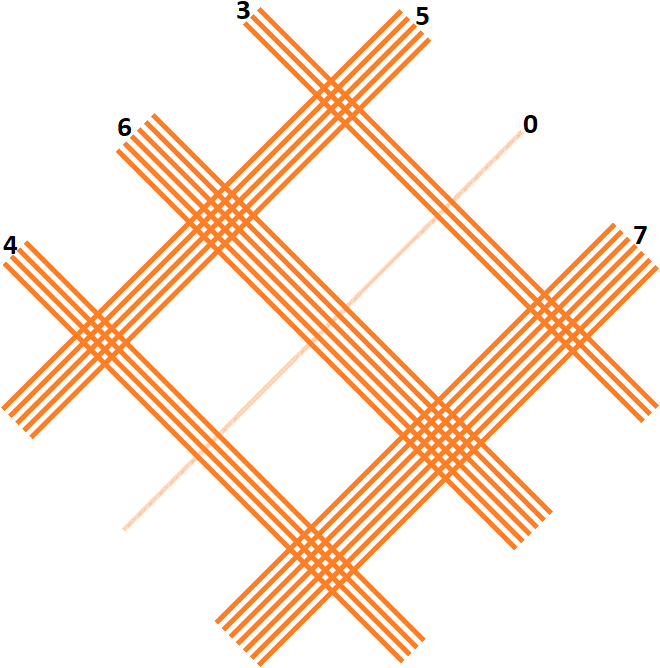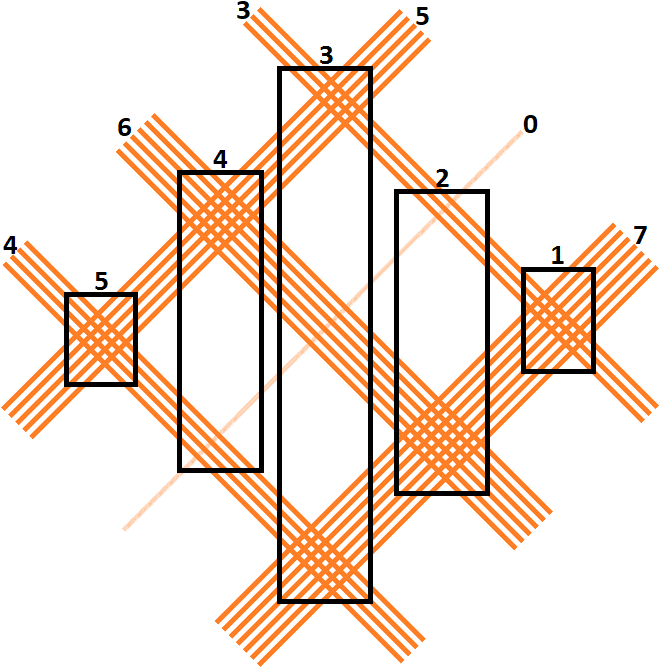6. The Japanese method of product calculation
The Japanese method of calculating products consists of drawing lines and counting the points of intersection between these lines to find the result.
This method looks like magic. But, if we study it closely, we will see that it is similar to the classical method of calculation, except... without the use of multiplication tables.
Before I describe the method and show its similarity to the classical method of multiplication, I will show you how to count a product of numbers using lines.
Counting a product of numbers with lines
Children start to count additions and subtractions with their fingers or with other objects. But at a certain level the addition tables should be known by heart.
Of course, the multiplication tables should also be known by heart. However, I will show you how to count a product of numbers.
For example: 6 x 4
A first solution is to draw a rectangle with 6 squares in length and 4 squares in width as follows:

Then count the number of squares. You will find 6 x 4 = 24.
Another solution is to draw 4 lines crossed with 6 lines as follows:

Then count the number of points of intersection between the lines drawn.

Japanese product calculation method
1st example
Let's calculate for example: 41 x 23
I start by drawing lines for each number by crossing the digits of the 1st value with those of the 2nd value, as follows:

Next, the intersections between the number lines should be grouped as shown in the following diagram. That is to say:
- 1st group: Intersections of the lines corresponding to the units digit of the 1st value with the lines corresponding to the units digit of the 2nd value
- 2nd group: Intersections of the lines corresponding to the units digit of the 1st value with the lines corresponding to the tens digit of the 2nd value AND Intersections of the lines corresponding to the tens digit of the 1st value with the lines corresponding to the units digit of the 2nd value
- 3rd group: Intersection of the lines corresponding to the tens digit of the 1st value with the lines corresponding to the tens digit of the 2nd value

I now count the points of intersection at group 1. I find the number 3 which is nothing but the product of the two numbers in unity, namely 3 and 1.
The first digit of the result is found. I put 3 in the unit cell.
![]()
I then count the points of intersection at Group 2. I find the number 14.
- At the top 2 which is equals 1x2 and
- At the bottom 12 which is equal to 3x4.
For the value 14, I put 4 in the tens class of the result, and I retain 1.
![]()
In group 3, I start counting from 2 in order to take into account the 1 carried from group 2. I find the number 9. Indeed, 1+(2x4)=9.

The hundreds digit of the result is 9. The result of the multiplication of 41 x 23 is :
![]()
Let us now calculate this product using the classical method of multiplication calculation, to see how similar it is to the Japanese method.
We start by multiplying 3 by 1 and this is what is found in group 1, which is nothing other than the product of 1 by 3.

Then we multiply 3 by 4, we get 12. This value is counted at the bottom of the 2nd group. And we multiply 2 by 1, we get 2. This value is counted at the top of the 2nd group. So we get 4 in tens with 1 held back for the hundreds box.

Then we multiply 2 by 4, we get 8 which is added to 1, carried from the 2nd group, to finally find 9 in the hundreds class.

2nd example
For example, let's calculate: 463 x 507
I start by drawing the lines for each digit as follows:

NB. For the diggit 0, a line must be drawn in dotted line or with another colour. The aim is not to count its intersections with the lines of the other value.
Next, the intersections between the lines of the digits must be grouped as shown in the following diagram. That is, :
- 1st group: Units-units
- 2nd group: Units-tens + tens-units
- 3rd group: Units-hundreds + tens-tens+ hundreds-units
- 4th group: Tens-hundreds + hundreds-hundreds
- 5th group: Hundreds-hundreds

I now count the points of intersection at group 1. I find the number 21 which is nothing but the product of the two numbers in unity, namely 3 and 7.
The first digit of the result is found. I put 1 in the units class and retain 2.
![]()
In group 2, I start counting from 3 in order to take into account the 2 carried. I find the number 44. Indeed,
2+(6x7)+(0x3)= 44
I remind you that you must not count the points of intersection with the line corresponding to the digit 0.
The tens digit of the result is 4, and I retain 4.
![]()
In group 3, I start counting from 5 in order to take into account the 4 carried. I find the number 47. Indeed,
4+(3x5)+(0x6)+(4x7)= 47
The hundreds digit of the result is 7, and I retain 4.
![]()
In group 4, I start counting from 5 in order to take into account the 4 carried. I find the number 34. Indeed,
4+(6x5)+(0x4)= 34
The number of thousands in the result is 4, and I retain 3.
![]()
In group 5, I start counting from 4 in order to take into account the 3 carried. I find the number 23. Indeed,
3+(5x4)= 23
The result is thus 234741.
![]()